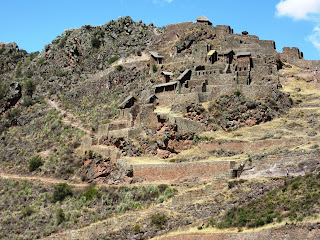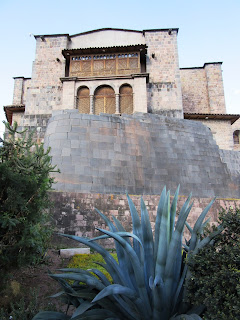Saturday - Sept 30, 2017 Cusco to Ollantaytambo
We were picked
up at our hotel at 8am and driven to Sacsayhuaman, where we were transferred to
a larger bus for our guided tour of the Sacred Valley. We were very pleased to
find that our guide was Puma Sanqo again.
The road north
from Cusco climbs up to a pass, undulates across the pampa and then descends
dramatically into the spectacular, fertile Urubamba Valley, which is also known
as the sacred valley.
Before reaching the pampa, we stopped at a llama, sheep, alpaca farm which had some exhibits about weaving. There were troughs of alfalfa to feed the animals and get them to pose nicely for pictures. The babies were very cute. Two people were very tardy returning to the bus after our visit and Puma read us the riot act about doing what he said.
The Urubamba River that flows through the valley was considered sacred by the Inca’s. The region is dotted with historic sites and archaeological ruins, signifying the importance of the region to both the Inca’s and the conquistadors. The Inca’s built their palaces, religious centers and retreats alongside this giant tributary of the Amazon, including citadels at Pisac and Ollantaytambo, both of which we visited.
Before reaching the pampa, we stopped at a llama, sheep, alpaca farm which had some exhibits about weaving. There were troughs of alfalfa to feed the animals and get them to pose nicely for pictures. The babies were very cute. Two people were very tardy returning to the bus after our visit and Puma read us the riot act about doing what he said.
The Urubamba River that flows through the valley was considered sacred by the Inca’s. The region is dotted with historic sites and archaeological ruins, signifying the importance of the region to both the Inca’s and the conquistadors. The Inca’s built their palaces, religious centers and retreats alongside this giant tributary of the Amazon, including citadels at Pisac and Ollantaytambo, both of which we visited.
The region is
considered sacred because of its vital importance to Cusco as a source of food
and grain. Quechua legend also holds that when the sun sets it slips through
the underworld beneath the Urubamba, where it draws deeply from the chill
waters and rises the next morning refreshed. A separate legend claims that the
earthly Urubamba is a mirror for the celestial river of the Milky Way, and that
the two flow into one another.
Pisac, Quechua
for partridge, was built by the man responsible for crushing the last Inca’s.
The village, with its traditional Andean markets, sits on the valley floor
while high above on a spur stands the citadel, a lofty Inca site set above a
series of giant sweeping terraces. A rare intact Intihuatana stands at the
ceremonial center of the citadel ruins - a sacred sculpted rock or ‘hitching
post of the sun’, the vast majority of which were decapitated by the
conquistadors.
The archeological complex at Pisac is made up of groups of terraces and different constructions that are harmoniously integrated with the hillside where they are built, they form the outline of a gigantic condor at the moment of beginning its flight and the whole forms an allegory of the constellation of the Condor.
The archeological complex at Pisac is made up of groups of terraces and different constructions that are harmoniously integrated with the hillside where they are built, they form the outline of a gigantic condor at the moment of beginning its flight and the whole forms an allegory of the constellation of the Condor.
In ancient
times the condor was believed to be the messenger of the Sun and the one in
charge of carrying the spirits of the dead on to the world beyond.
After visiting
the Condor mountain we stopped at the village for some retail therapy, visiting
a silver factory and then poking about the market stalls. I fell in love with
an alpaca blanket upstairs at the silver factory, but we were about to set off
on the Inca Trail and, even though my duffle bag was 2.4kg below the maximum of
7kg, I didn’t want to burden the porters with something like that. I mentioned
this to Puma later when we were wandering through the market and he said he
would deliver the blanket to our hotel in Cusco – so we took him up on the
offer and went back to the silver factory. The owner got involved in the transaction,
and said if we bought something else he would give us a big discount, so I also
got a silver Pachamama pendant that had caught my eye.
We then went
back to the market with Puma, who was trying desperately to round the group up.
All were accounted for except the Russian fellow from Moscow. We all piled on
the bus and Puma must have had his spies in the market because down the road we
stopped and picked up the Russian, who seemed to be very relieved to be
reunited with the group.
We went for
lunch at a very large and busy restaurant, with beautiful gardens. The food was
delicious and a wedding had just occurred which provided entertainment admiring
the dresses and flowers of the wedding party.
Our final stop
of the day was the fortress and religious complex of Ollantaytambo. The massive
ruins set above a compact town are some of the most striking and impressive in
the whole of Peru.
One of the stages in the development of art in civilizations ‘was man’s preoccupation with understanding the celestial universe and with developing systems that allowed him to understand and record its phenomena through means of an oral tradition, as well as a tendency to personify spiritual power and make it material’ (Grieber). This helps us to understand the reason for each of the special characteristics of the complex at Ollantaytambo.
One of the stages in the development of art in civilizations ‘was man’s preoccupation with understanding the celestial universe and with developing systems that allowed him to understand and record its phenomena through means of an oral tradition, as well as a tendency to personify spiritual power and make it material’ (Grieber). This helps us to understand the reason for each of the special characteristics of the complex at Ollantaytambo.
To fully apprehend
the monument, it is necessary to climb high above the valley. Unfortunately, we
didn’t have the five or six hours it would have taken to hike the continuous
ascent to reach the dwelling place of the mountain spirits, at a place called
Intipuncu, or Gateway of the Sun.
Instead, when
we entered the complex, Puma got a book from one of the vendors and referred
heavily to pictures in it to explain the significance to the Inca’s of the
religious and astronomical features of the complex.
Looking at an
aerial photograph of Ollantaytambo, you can see that the whole complex forms
the gigantic representation of the Sacred Tree.
At the left, representing the fruit, is the pyramidal construction of
the Pacaritanpu, or House of Dawn, which is the site of the Inca’s mythic
origin.
Since nothing
in the world can be planned without knowing about time, the Inca’s set up
landmarks and fixed points to study the movement of the celestial bodies. Many of these landmarks were mountains which
they held to be sacred because they were associated with the idea of being the
axis of the world. Such was the case of Pinkuylluna. The sunrise over the peak
of Pinkuylluna on the spring equinox is seen distinctively from the Incahuatana
(which is high above the terraces at the Ollantaytambo complex and where we
should have been to fully appreciate the site) and the Pleiades and the Sun at
dawn on the winter solstice is seen from the temple of the Sun.
Tunupa, the pilgrim preacher of knowledge and master knower of time, was represented on the mountain Pinkuylluna, in gigantic sculpted profile. His face looks out over the abyss from the cliff that serves as his body and upon which they drew his hands which seem to support a giant pilgrim’s rucksack. Pinkuylluna is across a valley from the temple complex.
A temple which represented a lama was built on the flanks of Tamboqasa mountain, which is where we spent our visit. In the vast territory encompassed by the empire of the Incas there was nowhere that the army went without being accompanied by thousands of these beasts of burden, under the everlasting presence of their celestial archetype, a constellation located just beneath the Southern Cross.
The ancient
and still inhabited urban sector of Ollantaytambo is a city dedicated to corn.
A great part of the political and economic power was concentrated here in
ancient times because of the high production corn. The oldest corn cobs in
South America were found in Peru and in time this grain would revolutionize the
Andean societies thanks to the control of its cultivation and the creation of
new varieties that were used as tolls for civilizing and controlling. Corn thus
became an important element in their religious beliefs and was often used as a
special element in the worship of Nature. Chicha, a drink made from corn was
used during festivals and ritual acts, and is still important today.
Puma, was very
proud of his Quechua heritage. He stressed the impressive and advanced
architectural skill of the Inca’s, very evident at the Ollantaytambo complex as
well.
When we left, he stopped at the vendor to allow people to purchase the book. I said I’d like one but couldn’t carry it, and he said, ‘just put it in with the blanket and I’ll deliver it to your hotel in Cusco’, which I did.
When we left, he stopped at the vendor to allow people to purchase the book. I said I’d like one but couldn’t carry it, and he said, ‘just put it in with the blanket and I’ll deliver it to your hotel in Cusco’, which I did.
Our hotel was
just down from the square where the bus was parked, so we fetched our bags from
the bus and a guide appeared that escorted a number of us to our various
hotels. We thanked Puma vigorously for helping us and gave him a tip well in
excess of our ‘big’ savings on the blanket and pendant.
We were pretty excited about starting our trek tomorrow, and still full of the big lunch, so we just had some Andean soup for supper and went to bed early.
We were pretty excited about starting our trek tomorrow, and still full of the big lunch, so we just had some Andean soup for supper and went to bed early.
We stayed at Sol de Ollantay, which is located in the heart of this
ancient Inca city, directly on the banks of the Patacancha river. The property
had fantastic views of the surrounding mountains and was an ideal spot to stay
prior to our trek. This is a picture taken from our hotel of the mountain Wakay
Willca (Tear of the Sun), which is said to be the guardian spirit of this part
of the valley.
The hotel manager was full of ambitious suggestions on what we could do that evening, but we were pretty tired from climbing all over the ruins at Pisac and Ollantaytambo and thought we better gather some strength for the trek tomorrow.
The hotel manager was full of ambitious suggestions on what we could do that evening, but we were pretty tired from climbing all over the ruins at Pisac and Ollantaytambo and thought we better gather some strength for the trek tomorrow.











































